Of course, it is an IT Governance issue
If I asked a hundred IT leaders if they needed additional resources, none of them would reply, “No thanks, we’re good on resources.” We see it all the time. IT departments are traditionally short on resources—or are they? If I added 10 FTEs to your budget today, you would most likely need another 10 shortly after, then another 10 after that.
I have talked with countless clients who, in our conversations, will sooner or later ask me to help them understand how to manage their resources optimally to meet the growing demands of the business. Now, I’ll admit that some IT organizations need help there, but guess what? It is just as important to manage demand, and that is a business responsibility. I’ll also admit that IT should become more agile in its delivery techniques as many do with the adoption of Agile and DevOps techniques. I’m a big supporter of these techniques. Yet, if you cannot figure out your waterfall delivery approach, be careful in thinking that a faster-paced technique is going to work for your organization anytime soon.
I recently worked with a client who asked me and a collection of other consultants to help them develop their IT Governance program by providing training and advice on the latest trends we’re seeing in today’s complex fast-moving environments. I consider myself pretty knowledgeable in IT Governance and I was surprised that their view of IT Governance was all about fixing the imbalance between the needs of the business and the capacity of the IT organization to deliver on those needs. I quickly realized that to them, this was IT Governance, and a part of me agrees.
If you aren’t convinced that this is a governance issue, let’s take a closer look at the relationship between governance and management. Governance ensures that stakeholder needs are evaluated, direction is set through prioritization and performance and compliance are monitored. Management then plans, builds, runs and monitors activities in alignment with the governing direction. The resource and demand issue is clearly an area that must be both governed and managed. There are multiple altitudes of governance. These range from the board of directors, to executive and steering committees, and change boards. Each of them has their own governance models guiding them on how they provide direction to the areas within their scope.
The demand avenues
As illustrated in the figure below, typical IT organizations struggle with multiple, non-governed demand intake streams and are constantly under pressure to prioritize work on behalf of the business. Don’t get me wrong, I’m not placing blame on the business here because the business exists to create value for stakeholders and therefore must continuously respond to internal and external factors as well as strive to foster innovation to stay ahead of competition. I see the majority of these demand avenues are generally ungoverned by the business. IT is then painted into the corner of having to prioritize work that the business needs delivered without clear guidance and prioritization.
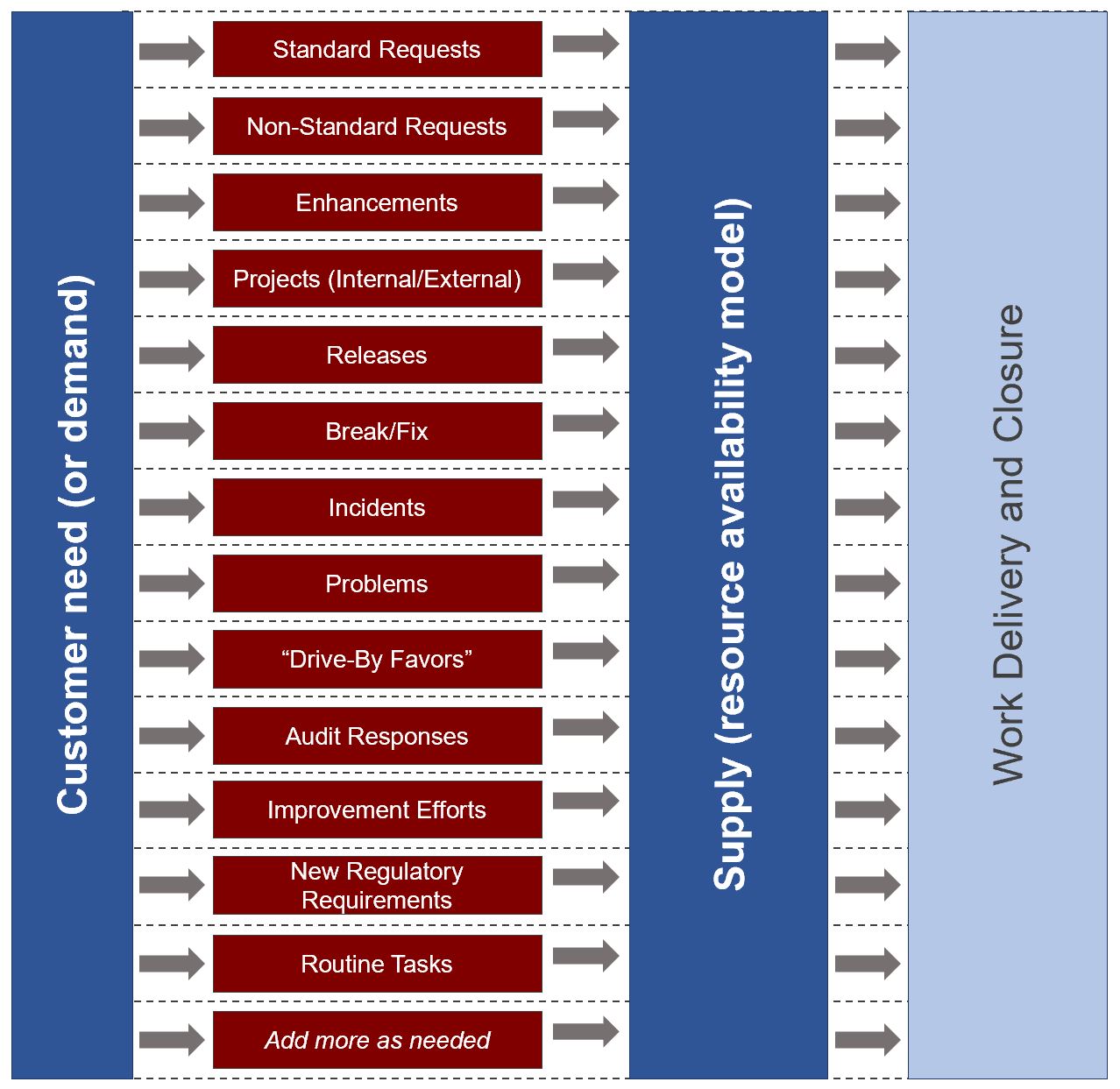
Figure 1, Sources of Demand
There are multiple avenues of demand. I won’t go through and describe each one of these, as each of you has your own, but I can say with confidence that you recognize most of these.
Here’s where the issues start, and I can guarantee most of you have been in this situation. The typical scenario looks like this: You are the Director of IT for a company and one of the business executives has just approached you with a new “high priority” project that needs to be accomplished to meet new regulatory requirements in the industry. The conversation goes like this:
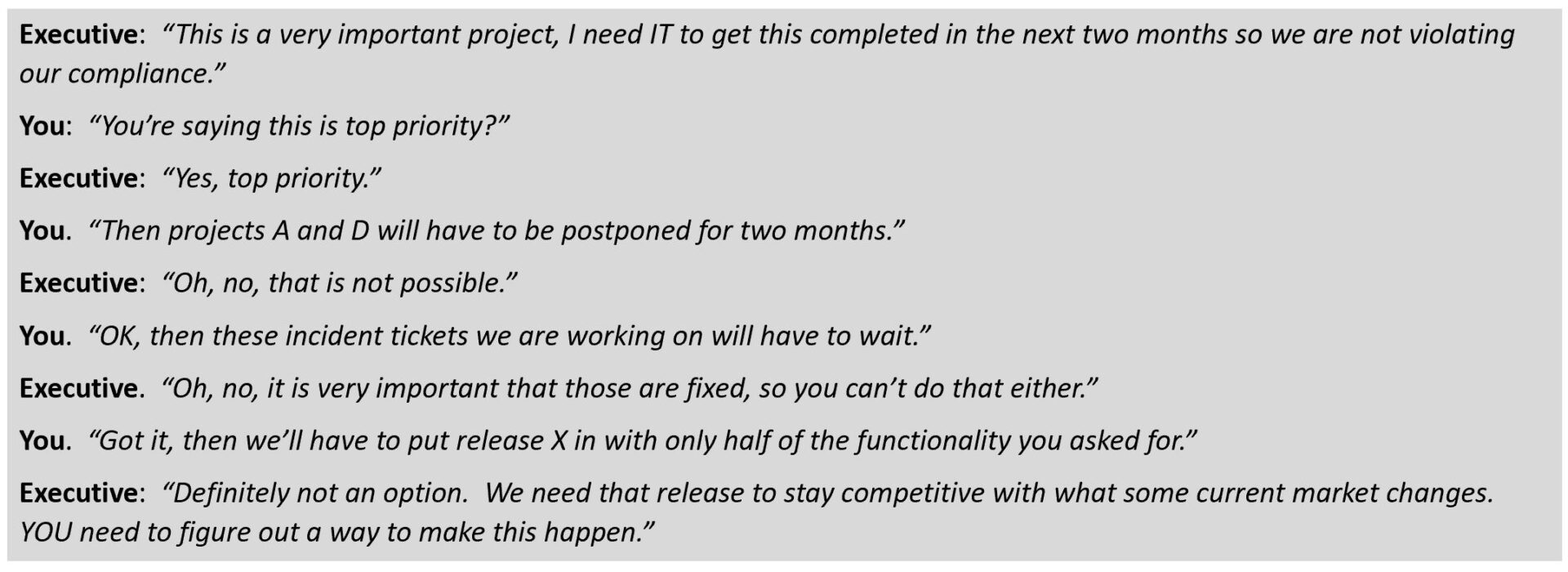
Have you ever been in a situation like this? I’ll bet the answer is yes, countless times. The primary issue here is that enterprise IT governance doesn’t understand that IT is not in a position to prioritize work. The business needs to do this, but with IT’s help, of course. We can balance these demands with our supply if we know 1) the business priorities, and 2) our capacity to support those priorities.
Sources of Supply (Capacity)
Resources include many areas and are consumed during the delivery of a service. They are finite and should be allocated based on creating value for stakeholders and business priorities. Within the context of this blog post, assume that supply is directly linked to resource capacity. The resources IT depends on typically include:
- Time
- People and skills
- Services
- Infrastructure
- Applications
- Information
- Suppliers
- Funding
IT generally struggles when it comes to understanding 1) what resources they have, 2) where resources are engaged, 3) what work they are doing, 4) what technical skills are over/under utilized, and finally 4) the priority of the work they are performing. The first reaction is to purchase a tool to do this, but as many of us know, “a fool with a tool is still a fool.”
Balancing Demand with Supply
Now that we understand the avenues of demand and sources of supply, let’s look at the next issue: how to balance demand and supply. There are multiple frameworks in our industry today that can help, but one of my favorite “go-to” frameworks is COBIT. ISACA’s latest release of the framework, COBIT 2019, has the answers we are looking for. By using Governance and Management Objectives, COBIT identifies the key areas that must be accomplished for Information and Technology (I&T) to contribute to enterprise goals. There are 40 of these objectives, and each one relates to one process. The following figure identifies these 40 processes.
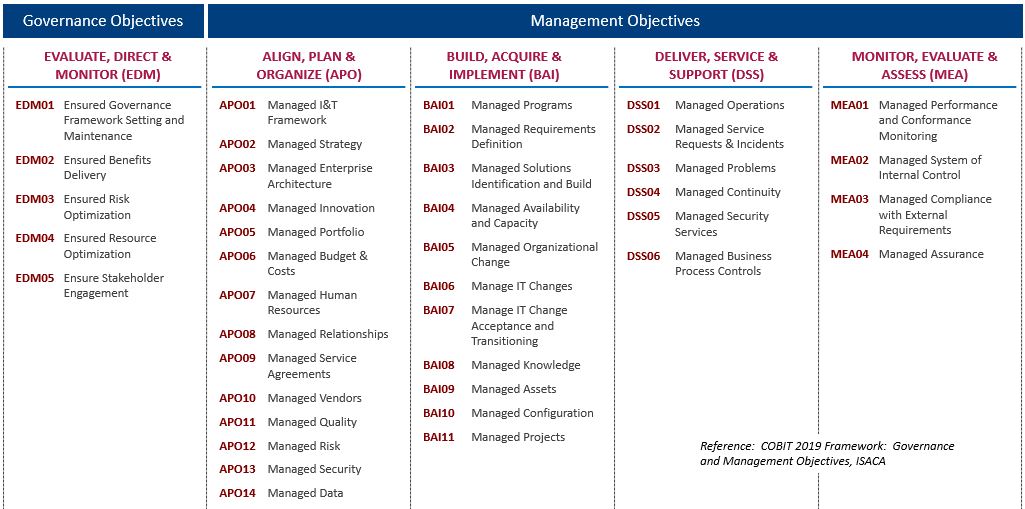
Figure 2, COBIT2019 Processes
We could spend hours looking through each of these processes and determine which ones directly relate to this balance, but I’ve boiled it down to the following key processes. This blog post will not go through all the practices and activities of each process. Rather, it identifies how organizations can determine how processes support the overall goal of creating value for stakeholders.
Do yourself a favor and look into the practices, activities and reference the COBIT framework offers. In addition to COBIT, the ITIL framework also provides some advice here. To download the COBIT 2019 guides, visit www.isaca.org.



Although referencing these processes helps, you need to map out the activities required to actually balance this. Here are some ideas that might help:
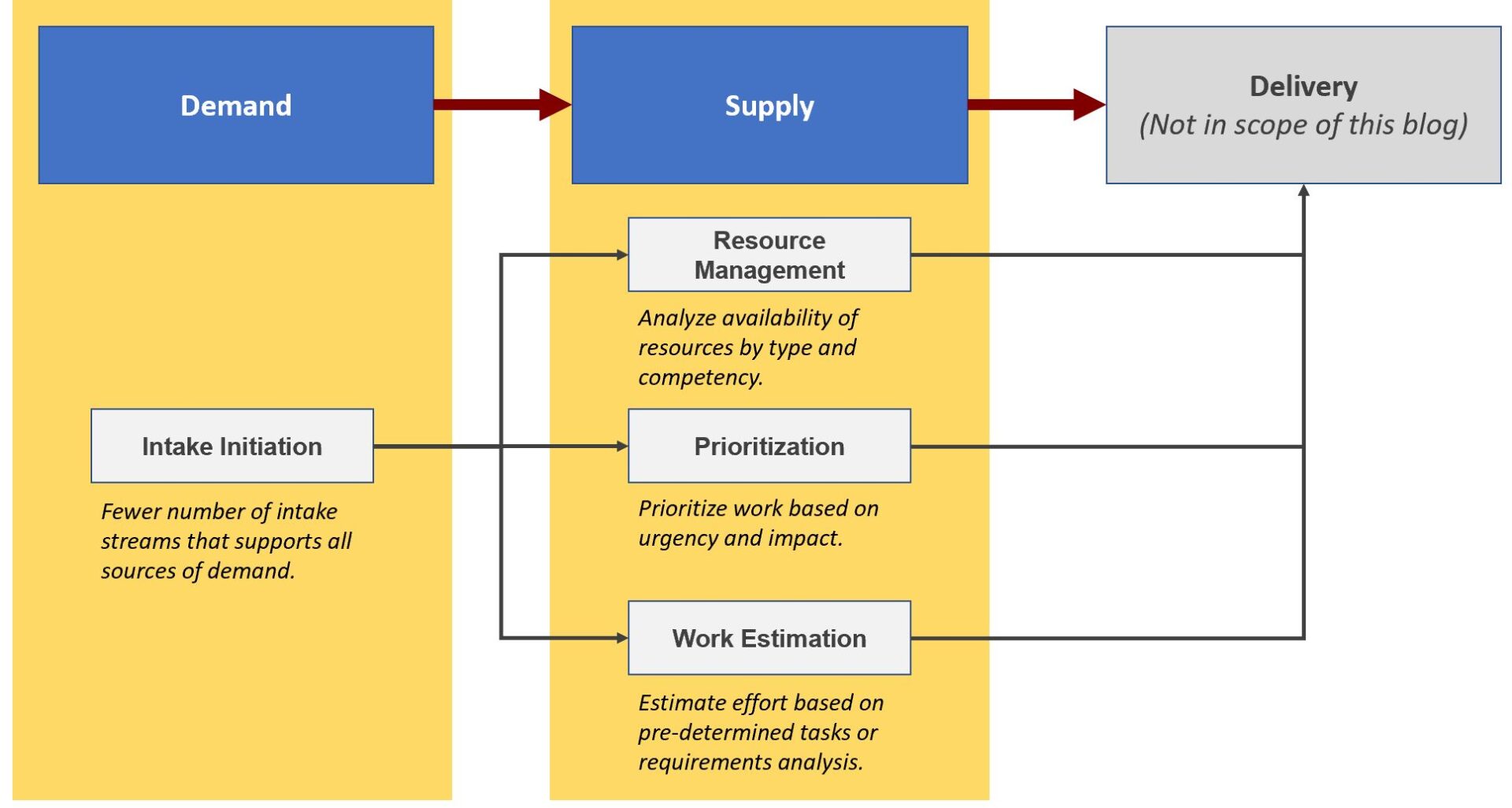
Figure 3, Balancing Demand and Supply
Suggested methodology
There is no silver bullet to solving this issue. Many factors must be considered, such as organizational structures, culture, risk profiles, governance posture, and of course skills and competencies. Below is a suggested methodology that is applicable to any organization that is struggling with its supply/demand imbalance.
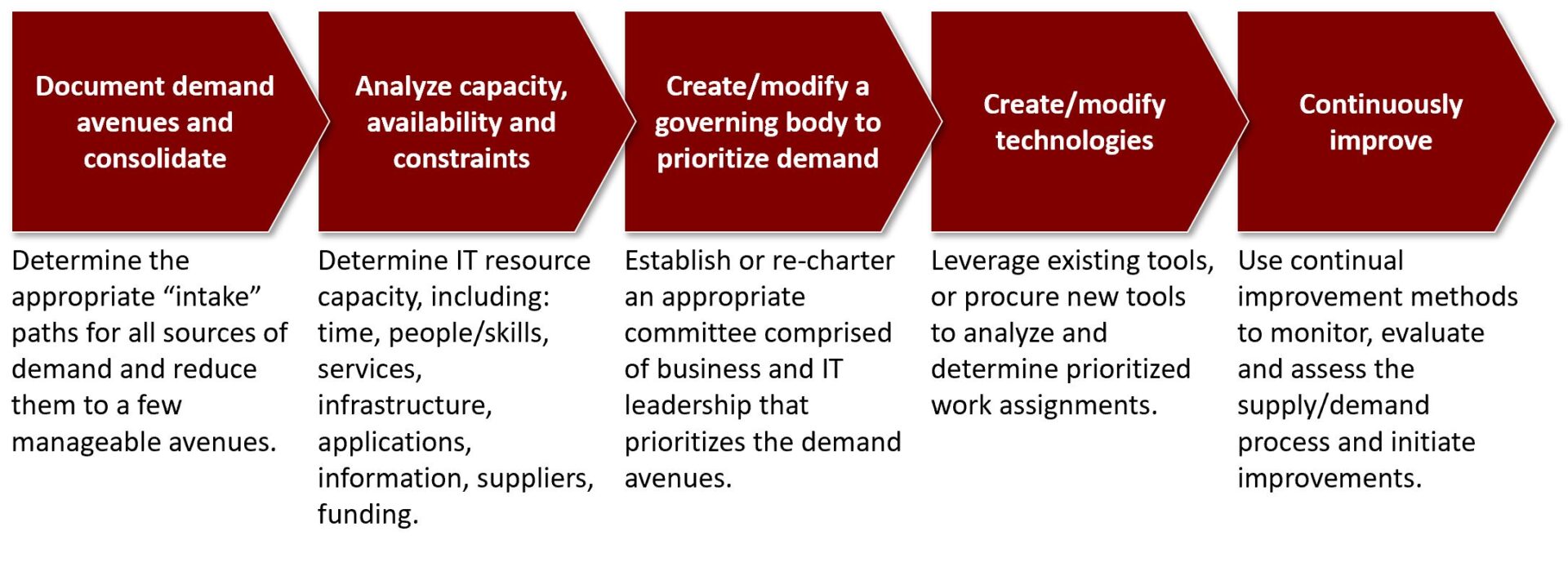
Figure 4, Suggested Methodology.
Top 5 Tips to balancing demand and supply
I’ve covered a lot of ground in a very short blog post. To summarize, here are my top 5 tips to balance your demand and supply processes:
- Document services in an IT service catalog and create Service Level Agreements (SLAs). This is key. If you don’t have your services documented and agreed on, then you are simply providing ‘favors’ with no expectations set. Make sure you analyze the underpinning vendor contracts and internal agreements that support the SLAs.
- Consolidate your demand avenues to a manageable number. Reduce the exposure to a few intake mechanisms that can prioritize work across fewer streams. For example: The Service Desk, Business Relationship Management and Portfolio/Program Management.
- Create a governing body that focuses on IT work prioritization for all demand avenues. This body should have representation from all sources of demand as well as IT delivery organizations.
- Understand all resources available. Document all capacity requirements and analyze their unique attributes. If you have 4,000 hours available, that doesn’t mean those 4,000 hours are the right resources for the work required.
- Mature the business relationship management (BRM) process. This will be one of the most significant demand avenues since BRM is translating business needs into IT requirements.
I hope this helps, and as always, your reactions and feedback are appreciated.

